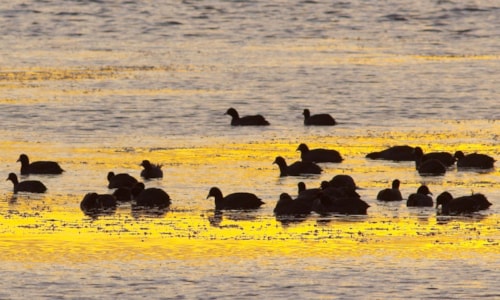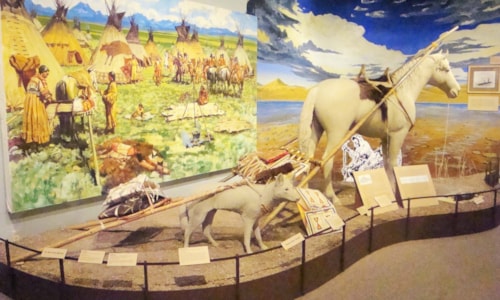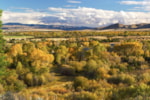Wildlife Viewing

The wide open spaces of Southwest Montana are home to an incredible variety of wildlife. This untouched habitat lends itself to some incredible opportunities for wildlife viewing. Southwest Montana’s diverse habitat is home to everything from majestic elk and massive grizzlies to deep diving waterfowl and high flying raptors. Make sure to bring your binoculars or even a spotting scope as you explore Southwest Montana because you never know what you might see!
There are several wildlife management areas and wildlife refuges that offer excellent wildlife viewing access. Use this page as a starting point for your exploration of Montana’s wildlife, or visit Montana Fish, Wildlife and Parks for more information.
Southwest Montana is a birding paradise. As such, birding is a huge draw to the region. If you are looking for additional information about birding and birding trails, checkout this section!
-

Bald Eagle
Haliaeetus leucocephalusThe bald eagle is the national bird of the United States, and it can be seen flying around the lakes and mountains of Southwest Montana. Bald eagles have a wingspan between 66 and 90 inches. These regal birds appear bald given the white feathers that adorn their head while their bodies and wings are a dark brown. Bald eagles will often be found near water as their diet consists primarily of fish.
-

Bighorn Sheep
Ovis canadensisBighorn sheep have a small range in North America, including western Montana. With hooves that are designed to traverse steep and rocky terrain, you will often find bighorn sheep on the sides of cliffs and rocks, with their hooves designed to traverse steep, rocky terrain. Adult males may reach around 300 pounds while ewes seldom exceed 150 pounds.
-

Bison
Bison bisonThe American bison is the national mammal of the United States. This massive animal is also called the buffalo. These terrestrial mammals can weight up to 1,400 pounds. Bison can be found on ranches throughout the Bitterrrot Valley and Southwest Montana. Wild herds can be seen in nearby Yellowstone National Park. Bison primarily eat grasses and are culturally significant to American Indian tribes in the area.
-

Black Bear
Ursus americanusBlack bears can be found throughout most of North America, including Montana, and are generally smaller than grizzly bears. Grown males weigh between 180 and 250 pounds. Despite what the name suggests, black bears can also be brown, white, chestnut or blonde. While they’re at the top of the food chain, black bears are not known to hunt for meat. They tend toward berries and plants, and sometimes fish and grubs. These bears are opportunist feeders and are infamous for stealing unattended food.
-

Bobcat
Lynx rufusBobcats vary in color from spotted to solid grays, browns and reds and can be found throughout North America. These cats are roughly double the size of domestic house cats. Grown males weigh around 35 pounds. These small predators tend to spend time in grassy areas and shrublands.
-

Elk
Cervus canadensisElk are among largest members of the deer family (second to the Moose) and as such, one of the largest land mammals in North America. Adult males have large antlers which are shed annually and they can weigh between 500 and 600 pounds. Elk are migrators, summering at higher elevations and wintering in lower elevations. Montana’s elk population is a significant draw for hunters and wildlife viewers alike.
-

Golden Eagle
Aquila chrysaetosThe golden eagle can be found throughout North America, from Canada down into Central America. They are brown in color with a golden sheen on the back of the head and neck. These birds and have a wingspan between 80 and 94 inches. Unlike the bald eagle which flies with board straight wings, the golden eagle will be seen in flight with their wings in a slight “V” with their wingtips spread like fingers.
-

Gray Wolf
Canis lupusDespite their name, gray wolves are not always gray, but can be either brown or black as well. Adult males generally weigh around 100 pounds. While the gray wolf is not migratory themselves, they do follow ungulates within their territory. Wolves historically ranged throughout most of North America and into Central America but can now only be found in small patches near the Canadian border states, this includes parts of western Montana. Wolves are pack animals and usually travel in large family groups.
-

Grizzly Bear
Ursus arctosIn the lower 48, grizzly bears are found in Montana, Idaho, Wyoming and a small part of Washington. Grizzlies are generally much larger than black bears, and grown males weigh an average of 440 pounds. Grizzly bears are solitary animals with the exception of young cubs and mothers. The grizzly bear is a top predator species in the Montana ecosystem. They hunt deer and elk and will often be found near waterways. While it is a rare behavior, grizzly bears can become aggressive toward humans when they feel threatened. It is suggested that, as a precaution, hikers carry bear spray while exploring bear country.
-

Moose
Alces americanusMoose are prevalent in Canada and can be found in a small territory that includes Montana. These ungulates are usually solitary, and males can weigh up to 1,200 pounds and are considered the tallest mammals in North America. Moose tend to live in the forests, wetlands, clear cuts, river valleys and mountain meadows of Montana, and often favor wet groves of willow or similar species.
-

Mountain Goat
Oreamnos americanusMountain goats have a majestic fully white coat year-round. Their hooves are designed to withstand rocky, steep conditions, and older males can weigh up to 300 pounds. In the lower 48 states, mountain goats are only found in small patches throughout Montana, Idaho, Wyoming and Washington.
-

Mountain Lion
Puma concolorMountain lions can be found from Alaska to South America, but in the United States, are most prevalent in the west. It is not easy to spot a Mountain Lion as they are solitary animals that spend their time in trees hunting deer and elk, usually at dusk, dawn and nighttime. These cats can weigh between 150 and 190 pounds.
-

Mule Deer
Odocoileus hemionusMule deer, or “muleys” as they are known to locals, are one of the two most common deer species in Montana and the western United States. Their ability to live throughout the entire state of Montana speaks to their adaptability. Mule deer are migratory animals, and adult males can weigh between 250 and 275 pounds.
-

North American River Otter
Lontra canadensisRiver otters are playful semi-aquatic mammals that feed on freshwater fish. They have a thick protective fur to help them stay warm in Montana’s cold river conditions. Their short legs, webbed feet and narrow bodies allow them to swim faster. River otters can stay underwater for up to 8 minutes.
-

Peregrine Falcon
Falco peregrinusWith an average wingspan of 35 to 44 inches, the peregrine falcon (one of the largest falcons) can be found across much of North America, especially the western region. These birds nest high on vertical cliffs to protect their young from predators and, for hunting purposes, are most commonly located near water. Adults are blue-gray above with barred underparts and a dark head with thick sideburns.
-

Pronghorn
Antilocapra americanaThe pronghorn is a species common to the western United States. For coloring, pronghorns have a reddish brown to tan back while their sides and lower parts are generally white. Adult males have horns that are 13 to 16 inches long with prongs and curved tips. Pronghorn males are solitary animals, though in the winter they may be seen with herds. Females and fawns can be found in small herds during the spring and summer. Pronghorns can run up to 55 mph, and adult males can weigh up to 125 pounds.
-

Red Fox
Vulpes vulpesThis small animal is dog-like in appearance. They boast a long bushy tail, pointed ears and slanted eyes. Unlike the Coyote, Swift Fox, Marten and Fisher, Red Foxes has a white tipped tail. Adult males weigh up to 15 pounds. These foxes are most commonly found in forested areas throughout Montana.
-

Striped Skunk
Mephitis mephitisThe striped skunk is a creature specific to North America and is about the size of an average house cat, with adult males weighing up to 14 pounds. Skunks emit a strong odor as a defense mechanism against predators, and they are mostly nocturnal.
-

White-Tailed Deer
Odocotleus virginianusThe white-tailed deer has a grayish-brown coat in the winter that turns a reddish-brown shade in summer. Most notably, the white-tailed deer has a roughly foot-long tail with a white underside that when alarmed or running stands erect. This is the most common deer species in the United States. Mature males weigh between 250 and 275 pounds. These animals occupy a small home range and do not migrate far.
Southwest Montana is the perfect place for wildlife watching, as you go out to explore the pristine wilderness that these animals call home, we urge you to practice responsible wildlife viewing. Here’s some quick tips for wildlife viewing: keep a safe distance, make your presence known but avoid making loud noises when observing wildlife in their natural habitat, don’t feed the wildlife, and leave no trace.
Looking for additional tips or resources? Check out the National Park Services 7 Ways to Safely Watch Wildlife article.



















